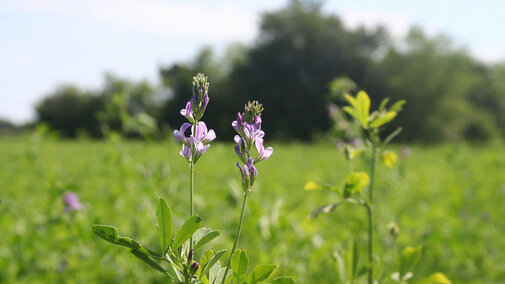Grass and Alfalfa Mixtures
By Jerry VoleskyInterseeding cool-season perennial grasses into older alfalfa stands has been a good option to increase the productivity of that field. If planning a new alfalfa seeding this year, using a grass and alfalfa mixture can also have some advantages.
If you regularly feed more than five or six pounds of alfalfa per day to stock cows during winter, they probably are getting way more than enough protein but maybe not enough TDN or energy. Mixing grass with alfalfa usually lowers the protein but slightly increases the TDN content of hay. So, your cows actually could receive a more balanced diet. Also, if you sometimes graze your hay fields, grass will reduce the risk of bloat.
In the field, grass can grow in areas where alfalfa is not well-adapted or fill in spots as alfalfa dies out. This is better than having weeds invade bare areas. Grass-alfalfa mixtures often dry out more rapidly after cutting than pure alfalfa, so you might get more hay made without rain damage. And if it does rain, grass sheds rain well so the mixture usually suffers less injury, both in the windrow and in the bale.
Yield-wise, protein yield may be less with the mix, but total tonnage usually is about the same or higher than pure stands. Most of the grass yield will come at first cut, so regrowth will be mostly alfalfa. Selling a mixture can be more difficult though, because dairies prefer pure alfalfa and grass is more difficult to grind.
Orchardgrass is a top choice for seeding with alfalfa, but other grasses like smooth brome, meadow brome, festulolium, or wheatgrasses will work as well. The seeding rate of the grasses will vary depending on the species that is used and what proportion of grass and alfalfa is desired.
Spring Alfalfa Plant Evaluation
By Ben BeckmanAs temperatures begin to rise, don’t forget to take a bit of time to assess alfalfa stand health going into this year’s growing season. Snow cover over the winter helped insulate plants from extreme temperatures, but exposed plants, older stands, or late harvested alfalfa still have a potential for winter kill.
Even before plants begin to green up, individual plant assessments can be done. While assessment before green-up occurs may seem a bit preemptive, pre-scouting now can focus scouting efforts to problem areas later on when time becomes precious during spring planting.
- Dig up four to five random plants per 20 acres, being sure to get the crown and a good portion of the tap root (around six inches at least). Split the root and crown open. A healthy plant will be white and firm, while winter damaged taproots will be yellow to brown in color and stringy. Yield will begin to be impacted when damage is greater than 30% of the total root/crown area.
- Look for alive, intact basal buds at the crown of the plant. Buds formed last fall will start growth sooner and boost first cutting yields. A lack of basal buds doesn’t mean that the plant won’t recover, but first cuttings may be smaller.
- If plants have begun growth, look at where it is occurring on the crown. Healthy plants will have growth fully throughout the crown while damaged plants will often have asymmetrical growth with more stems on one side than the other.
If more than 30% of the plants assessed have significant damage, yield for the upcoming year may be impacted. Options like interseeding perennial grasses, seeding a warm-season forage crop after the first harvest, or terminating the stand may need to be considered.

